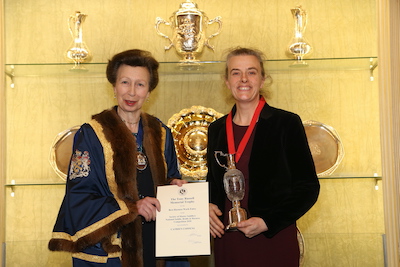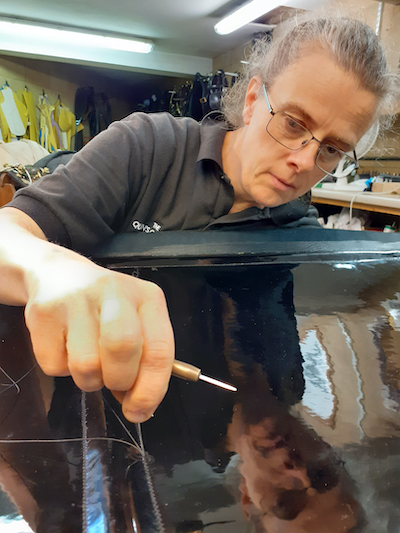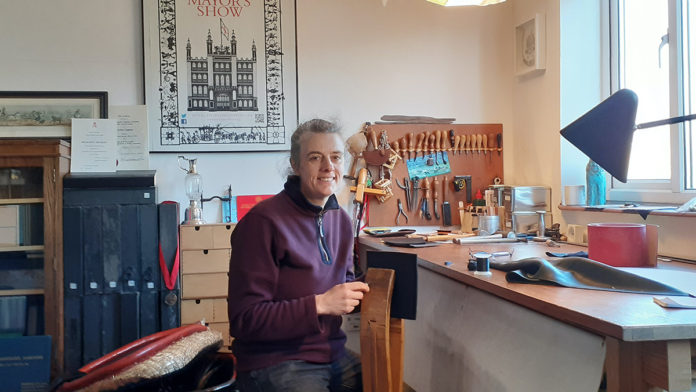It’s all in a day’s work for this award-winning saddler.
ETN’s Bench Saddler of the Month award, presented in conjunction with the Society of Master Saddlers (SMS), recognises those whose good practise is making a difference in the saddlery industry.
This month’s winner is Catrien Coppens.
Catrien has been nominated by Master Harness-Maker Matthew Payne, who says: “I first met Catrien at the Royal Mews in 2004 while I was an intern. I was so impressed with her harness-making ability; she has amazing attention to detail.
“I honestly believe Catrien one of the best harness-makers in the country, probably Europe - if not the world! A number of royal families throughout Europe, including Sweden, have commissioned her to work on projects maintaining and replacing their state harness.”
About Catrien Coppens
As a child, Catrien always enjoyed making things; woodwork, needlework, art and pottery were her favourite subjects at school.
It was Catrien’s sister that got her – and the rest of her family – riding and owning two Icelandic horses.
“It was all good fun, times were different then,” recalls Catrien. “There was no health and safety; we used to ride bare-back, swim in the lake, jump the odd fallen tree, build our own cross-country courses, and go for long rides with friends.”
Having decided that making things would be her career, Catrien studied architectural design at art school in Holland. “Going to art school was almost a family tradition; many of my relatives are photographers, sculptors, painters, architects and graphic designers,” she says.
Catrien ended up working with an architect in London. And while living in the city, she discovered the saddlery course at Cordwainers College.
“I signed up with the idea of learning skills to use in architectural projects, but suddenly everything fell into place. I could combine my love for horses and my desire to make things; saddlery was the perfect combination of my interests.”
Master Saddler Frances Roche was one of Catrien’s teachers at Cordwainers. “Straight away, it was clear to me that she was good and I wanted to be taught by her, no one else. I’m really grateful for all Frances has taught me over the years.”
Catrien and Frances now work together at the Royal Mews in London.
Ceremonial harness
Today, Catrien is a harness-maker specialising in ceremonial harness, employed part-time at the Royal Mews and doing freelance work.

“It suits my brain perfectly; there’s a lot of fancy stitching and elegant detailing combined with the technical complexity of harness-making.”
She’s particularly proud of a project she’s been working on for almost two decades - the refurbishment of the 'fluted harness', a set of full state harness at the Royal Mews. “The project is almost completed and we’re looking forward to trying it on the horses and using it again for ceremonial occasions,” says Catrien.
“It’s such a privilege to take the old harness apart and admire the craftsmanship of the saddlers who made it more than 100 years ago. It’s always a challenge to replace like for like, or to try to do even better than the masters of old.”
Lord Mayor’s harness
For 15 years, Frances and Catrien have worked with the Royal Mews in Sweden, re-leathering most of their state harness. “It’s amazing to walk into their harness room and see all 'our' harness hanging on the walls,” says Catrien.
Another self-employed project of Catrien’s is looking after the Lord Mayor’s harness for the Corporation of London.
She also continues with architectural projects, from floors to handrails and seats to bed heads, using a variety of different leathers and techniques. “I also do work for other Royal households in Europe,” she says discreetly.
An amazing trade
Catrien reckons the most complex and technically challenging project she’s ever undertaken is the burgundy baroque bridle she made for the SMS National Competition in 2018. The idea for the raised pattern was based on the decorations on side-saddle pommels.
“We have an amazing trade,” she says. “We are very lucky to have the Worshipful Company of Saddlers taking a very active interest and being so supportive.
“And we’re fortunate to have the SMS as our trade organisation. It’s really important for people who work alone at the bench a lot of the time to feel part of a larger organisation.”
Traditional tools and skills

Catrien says that while industry might have changed over the years, she’s still working at the bench just as saddlers would have done 100 years ago.
“I very rarely use a sewing machine,” she says, “all skiving [cutting] is done by hand and the box loops are hand-checkered.”
In a nod to modern times, Catrien might use different types of glue and materials such as foam instead of felt, and an electric splitting machine.
But, overall, she adds: “The traditional tools and skills I use every day have probably not changed at all.”
To nominate a bench saddler
Everyone is invited to nominate bench saddlers they feel deserve to be named ETN/SMS Bench Saddler of the Month. Candidates for the award must be a member of the SMS and based in the UK or overseas.
To nominate a bench saddler (or more than one), email editor@equestriantradenews.com and tell us why this person deserves to be put in the spotlight. Please include the bench saddler’s name and business name too.

















